Family : Anomalopidae

Text © Giuseppe Mazza

English translation by Mario Beltramini
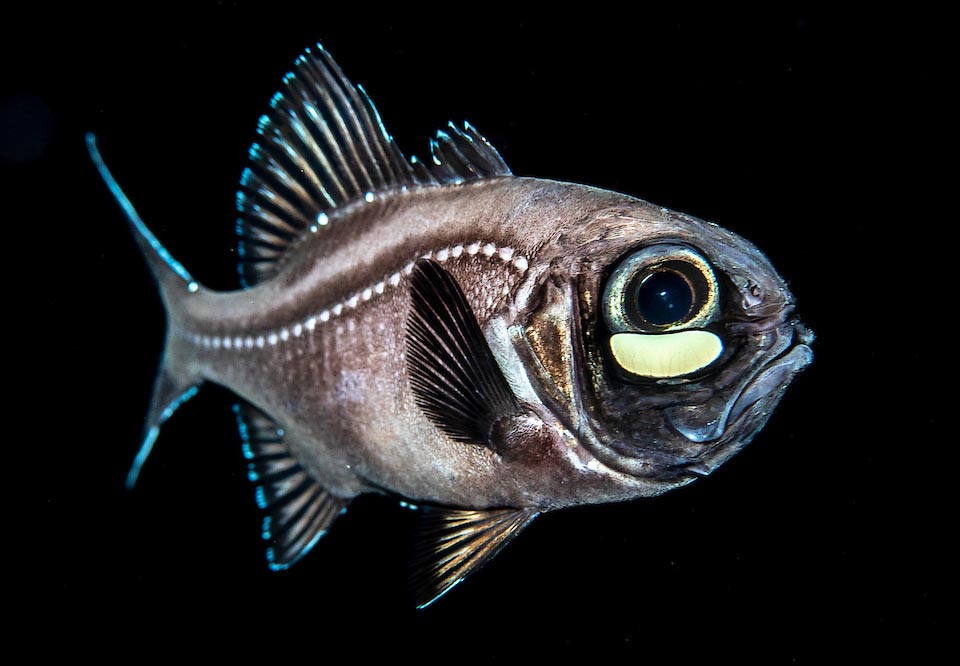
Present in Caribbean, from Bahamas to off Curaçao in Venezuela, the Atlantic flashlightfish (Kryptophanaron alfredi) lives in absolute dark, up to more than 200 m © Allison & Carlos Estape
The Atlantic flashlightfish (Kryptophanaron alfredi Silvester & Fowler, 1926), belongs to the class of the Actinopterygii, the ray-finned fishes, to the order of the Beryciformes and to the family of the Anomalopidae, the Lanterneye fishes.
The name of the genus Kryptophanaron comes from the Greek “κρυπτός”, (kryptos) hidden and “φανερός” (phaneros), visible, clear, with reference to the luminous organ that may be concealed, whilst the specific term alfredi honours the memory of Alfred Mitchell (1832-1911), American businessman who lived in Jamaica financing Ulrich Dahlgren (1870-1946), the biologist of Princeton University who found floating on the surface the specimens used for the description of the species.
Zoogeography
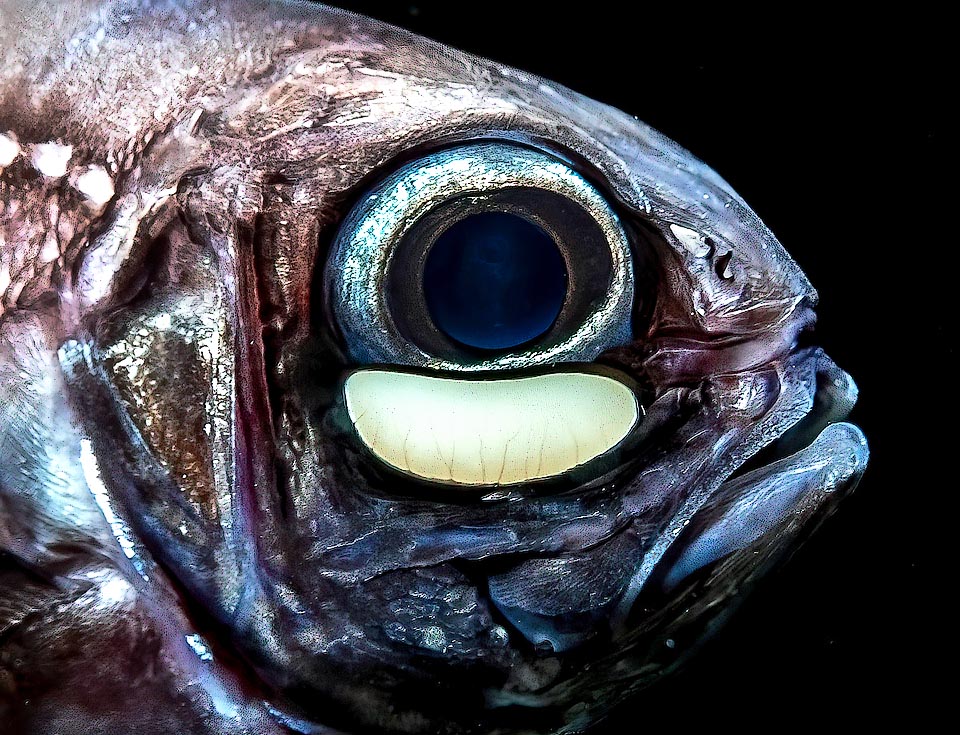
Under the eye has a luminous organ fed by millions of symbiotic bioluminescent bacteria. Obscured at times by a mobile eyelid it attracts the preys by flashing © Allison & Carlos Estape
Kryptophanaron alfredi lives in central-western Atlantic along the coasts of Honduras, Cayman Islands, Jamaica, Cuba, Bahamas, Haiti, Dominican Republic, Puerto Rico, Virgin Islands and off Curaçao facing Venezuela.
Ecology-Habitat
Hunting with luminous organs it is obviously a fish moving in the darkness, going down up to 200 m of depth, but in the moonless nights it can go up to about 20-25 m chasing on madreporic environments the zooplankton which it feeds on.
Morphophysiology
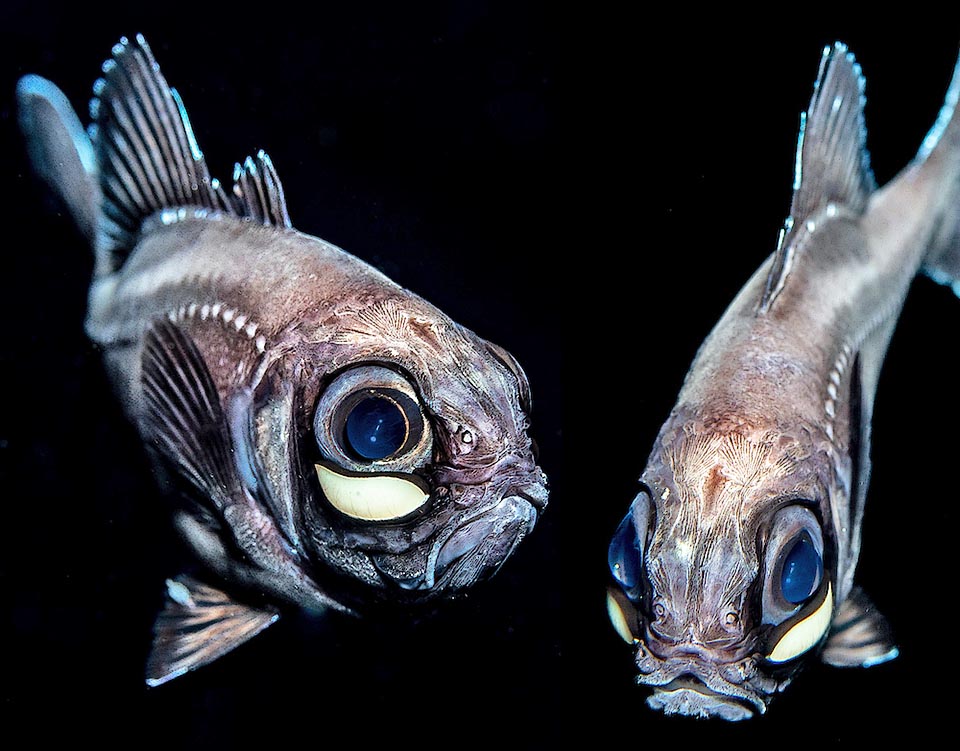
The scaleless black head has a short and blunt snout. To note the two showy nostrils and the sensorial channels between the eyes. The protractile mouth opens downwards © Allison & Carlos Estape
It can reach the length of 12,5 cm. The body, relatively wide, is chocolate in colour. The black head, without scales, has on the snout, short and blunt, two showy nostrils, and displays on top, between high crests, sensory channels covered with skin.
The protractile mouth, oblique with the slightly protruding mandible, opens downwards. It has bands of villiform teeth on jaws and vomer, but the tongue has none. The eyes, with dark iris, are very big, as suits to fishes living in the darkness, with a diameter bigger than the length of the snout.
Just below stands a luminous window of pale yellow colour, bean shaped, with a sort of black eyelid opening and closing inwards hiding completely or partially the strong light produced by millions of bioluminescent bacteria of the genus Photobacterium the fish hosts symbiont in a special organ, suitable for their growth, placed close to the mouth.
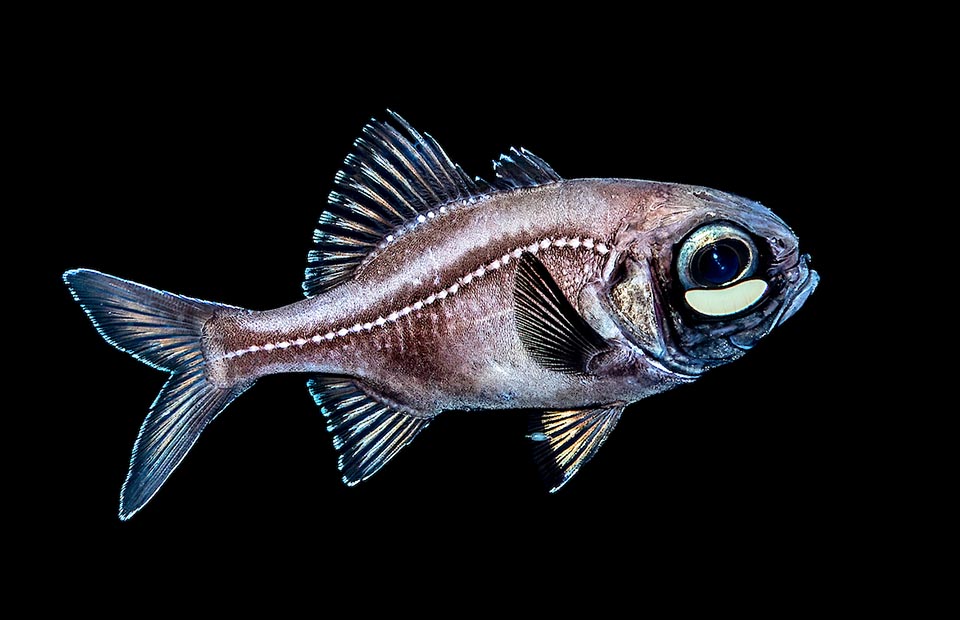
The lateral line, the base of the dorsal and of the anal fins have white keeled scales that reflect the light, as happens for the edge of the fins © Allison & Carlos Estape
A light to attract the preys and that allows the visibility necessary for swimming in the darkness on the seabeds.
The dorsal fin is divided in two contiguous parts. The first has 4 spiny rays and the second, much higher, 2 spiny rays and 14 unarmed. The pelvic ones, well developed, count one spine and 6 soft rays; the anal 3 spines and 10 soft rays. The pectoral ones, black, have 16-17 rays without spines. The caudal is furcated.
The lateral line is not straight like in the Splitfin flashlightfish (Anomalops katoptron) of western Pacific, but follows the curve of the back, and has, like the base of the dorsal fin and of the anal, reflective white keeled scales. In adults also the fins have an edge of reflective scales.
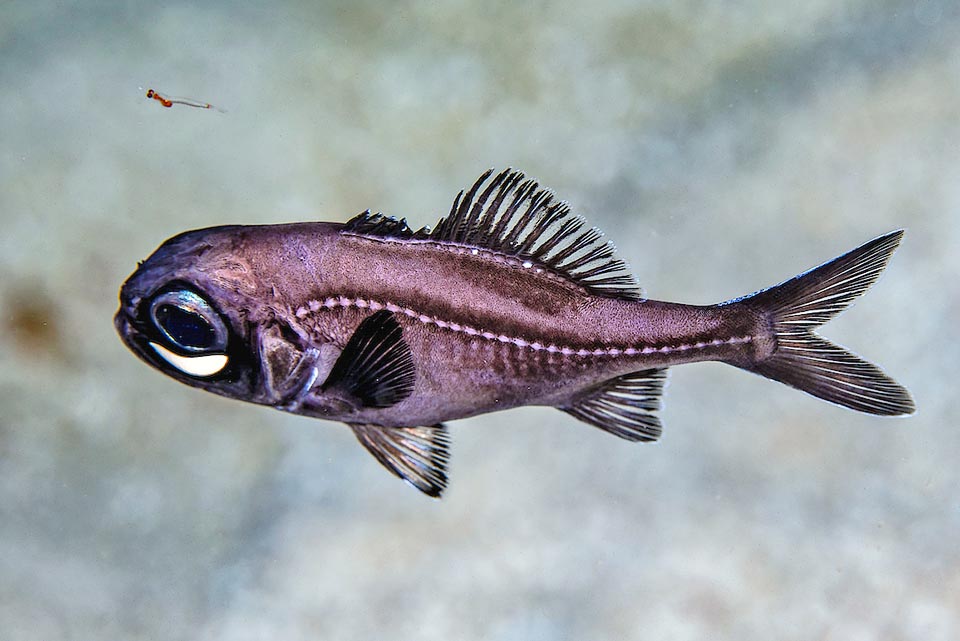
In the dark moonless nights, it can go up to about 20-25 m chasing the zooplankton it feeds on, chiefly microscopic shrimps as that visible here close to the head © Allison & Carlos Estape
Ethology-Reproductive Biology
Kryptophanaron alfredi nourishes mainly of zooplankton, usually microscopic shrimps and copepods. The divers have always seen it alone even if it is not easy to observe it in the dark due to the bioluminescent plankton. In fact, one notices its presence only when it is blinking the eyelids covering the lantern in order to attract the preys’ attention.
Almost nothing is known about its reproduction, but it is thought that eggs and larvae are pelagic. The fishing vulnerability is obviously minimal, rated 10 on a scale of 100.
In the IUCN Red List of the endangered species Kryptophanaron alfredi is classified “Least Concern”.
→ For general information about FISH please click here.
→ For general information about BONY FISH please click here
→ For general information about CARTILAGINOUS FISH please click here.
→ To appreciate the BIODIVERSITY of BONY FISH please click here.
→ To appreciate the BIODIVERSITY of CARTILAGINOUS FISH please click here.
